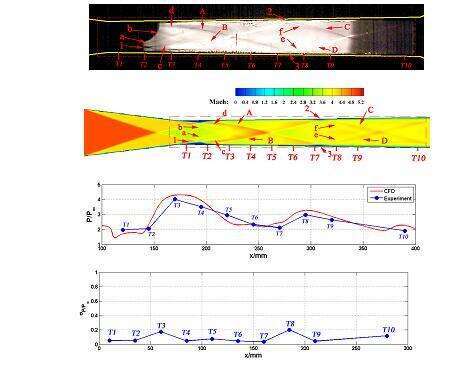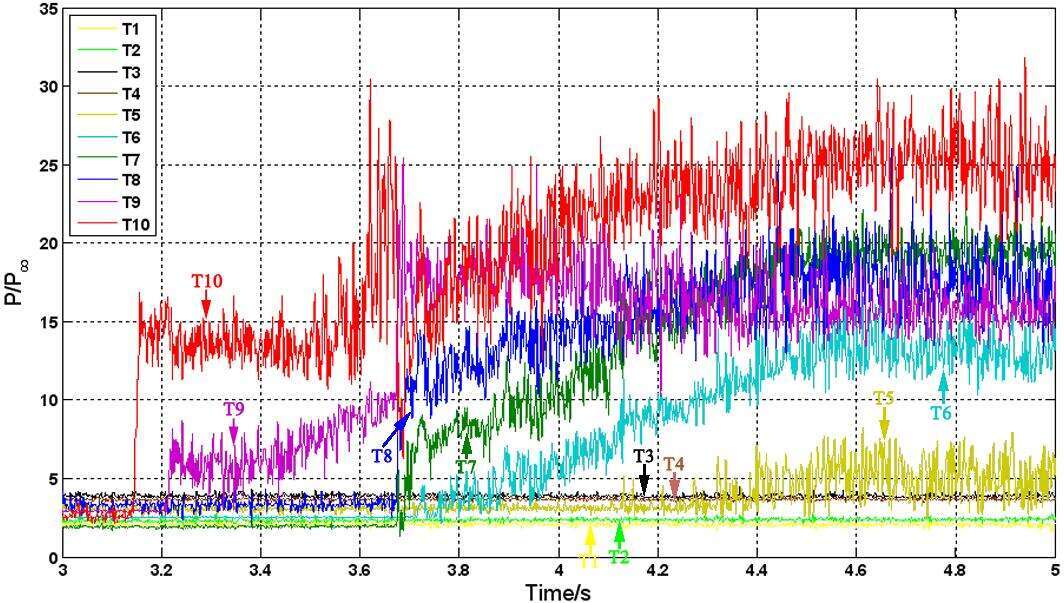The oblique shock train (OST) flow diffusion phenomenon, which involves an interaction between the duct’s peripheral boundary layer and central oblique-shock-wave field, usually appears in constant or nearly constant cross-sectional area supersonic/hypersonic duct flows. The study of such a complex flow structure in a confined duct under a finite adverse pressure gradient has important implications for the design and operation of a variety of devices including hypersonic vehicle inlet/isolator , supersonic wind tunnel diffusers , supersonic ejectors, and so on. To develop the design methods and control strategies of the flow devices, it is necessary to fully understand the mechanism of the OST. Different flow conditions will lead to different kinds of shock train structure: normal shock train occur for lower incoming Mach numbers of about 1.2–2, whereas oblique shock train occur for higher incoming Mach numbers. The aerodynamic performance of the fluid devices is well related to the features of the OST, which include the structure of the OST, the pressure recovery in the OST flow region, the dynamic characteristics of the flow separation region nearby the OST, and so on. In addition to complex flow structure, the OST inside the duct has an important feature of unsteady characteristics, even if the boundary conditions such as the pressures upstream and downstream of the OST region are held constant, the OST is still in “self-oscillation” state . This self-excited oscillation may cause the structural fatigue, unstart of inlet / isolator, instability of combustion. Therefore, the study of dynamic characteristics of the OST is important for aircraft structural design and aerodynamic performance evaluation.
Although a large number of previous studies have been done on the dynamic characteristics of the OST in duct , but there are still many issues unresolved and the rational understanding of OST phenomenon is not enough. Especially, the knowledge about the dynamic propagation process of the OST is the key issue for the development of hypersonic aircraft design and propulsion systems.
The current paper describes the results of an experimental study of the OST in a simple duct model that was mounted in a Mach 5 wind tunnel. Optical visualization of the flow in the duct was performed, and distributions of static pressure in typical longitudinal sections were obtained. Patterns of the OST in the duct were identified. The forward-propagation process of the OST has been analyzed based on the above data. The purpose of this study is to deepen the understanding of the dynamic characteristics of the OST in the duct and provide a fundamental research for the engineering applications.
The structure and dynamic characteristics of oblique shock train in a simple duct model are investigated experimentally in a Mach 5 hypersonic wind tunnel. The downstream back pressure of the rectangular duct is produced and varied by the close of two ramps at the end of the duct. Measurements made include high-speed schlieren imaging and simultaneous fast-response wall pressure along the length of the duct. The leading edge of shock train propagates upstream, and translates to be asymmetry with the increase of backpressure. Varying the rise speed of back pressure did not show any discernible effects on the propagation speed of the leading edge of oblique shock train. There are two kinds of motion modes in the shock train propagation process: steadily forward and rapidly forward. The characteristics of forward propagation of the oblique shock train are affected mainly by the structure of inflow, the pressure distributions of wall, the distance to the isolator exit.





